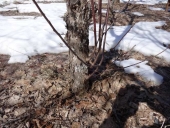
 1
1




Professional photographer and nature lover. Zone 8b, Bulgaria.
 1
1





 2
2




If you grow a medlar tree on its own roots it will grow to about 7m / 23ft tall and about the same width. This is too large for most gardens so all medlar trees sold in the UK are grafted onto dwarfing rootstock. The rootstock is the lower part of the tree and will be dwarfing - either quince or hawthorn. The upper part of the tree is a medlar. The rootstock will be responsible to a large degree for the overall size of the tree. Normally, grafted medlar trees grow to a height of 3m / 10ft and a width of 4m / 13ft, a very nice size for many gardens.
List of Bryant RedHawk's Epic Soil Series Threads We love visitors, that's why we live in a secluded cabin deep in the woods. "Buzzard's Roost (Asnikiye Heca) Farm." Promoting permaculture to save our planet.
 1
1




Professional photographer and nature lover. Zone 8b, Bulgaria.
















List of Bryant RedHawk's Epic Soil Series Threads We love visitors, that's why we live in a secluded cabin deep in the woods. "Buzzard's Roost (Asnikiye Heca) Farm." Promoting permaculture to save our planet.












 1
1




List of Bryant RedHawk's Epic Soil Series Threads We love visitors, that's why we live in a secluded cabin deep in the woods. "Buzzard's Roost (Asnikiye Heca) Farm." Promoting permaculture to save our planet.
 1
1




Sometimes the answer is nothing

















List of Bryant RedHawk's Epic Soil Series Threads We love visitors, that's why we live in a secluded cabin deep in the woods. "Buzzard's Roost (Asnikiye Heca) Farm." Promoting permaculture to save our planet.




Sometimes the answer is nothing

















List of Bryant RedHawk's Epic Soil Series Threads We love visitors, that's why we live in a secluded cabin deep in the woods. "Buzzard's Roost (Asnikiye Heca) Farm." Promoting permaculture to save our planet.
 6
6








Permies is awesome!!!
 2
2








Permies is awesome!!!




 2
2




There is nothing permanent in a culture dependent on such temporaries as civilization.
www.feralfarmagroforestry.com
 1
1




 1
1




 1
1





|
Royal Flush Bitches! Pay up tiny ad:
Homestead Pigs Course
https://permies.com/wiki/365748/Homestead-Pigs
|

